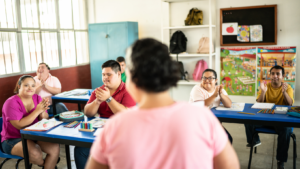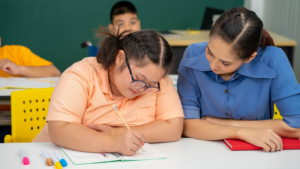In the ever-evolving landscape of education, a spotlight shines brightly on special education. It’s a field that’s constantly growing, adapting, and innovating to better serve students with unique needs.
So, let’s embark on this enlightening journey into the heart of special education news.
Special Education News
Special education news, continuously adapting to meet varying student needs, shows intriguing trends in technology and policy changes. These trends enlighten educators, parents, and other stakeholders on the evolution within the field
Technological advancements carve an essential niche in special education news growth. Cutting-edge tech solutions continue to emerge, transforming how specialized educators teach, and students learn. For instance, assistive devices, software applications, and online resources offer rich, accessible, and tailored learning experiences for special education students.

Digital tools, such as speech-to-text and text-to-speech software, overcome communication hurdles for students with disabilities in reading and writing. Apps, such as Proloquo2Go and TouchChat HD, help non-verbal students express themselves through pictures and speech output. There’s also an uptick in specialized educational platforms, such as BrainPOP and Khan Academy, offering interactive, customizable content catering to different learning styles. Virtual Reality (VR) and Augmented Reality (AR) technologies are breaking new grounds, providing immersive, engaging learning environments that boost cognitive skills, social interactions, and emotional well-being.
Policy Changes
Policy shifts in special education news demonstrate measurable impacts. Lawmakers, recognizing the imperative need for inclusive education, implement policies promoting equity, accessibility, and quality in special education news.

An emblematic example is the Individuals with Disabilities Education Act (IDEA), updated in 2004. It bolsters state’s early intervention programs, outlines special education services, and guarantees free, appropriate public education for students with disabilities. Additionally, the Every Student Succeeds Act (ESSA), passed in 2015, ensures that schools are accountable for how students with disabilities are progressing.
Major Challenges Facing Special Education
Despite the promising strides made in special education news, noteworthy hurdles persist. These challenges range from funding inadequacies to issues surrounding inclusion and accessibility.
Funding and Resource Allocation
A key challenge pertains to funding and resource allocation. The Individuals with Disabilities Education Act (IDEA) guarantees equitable education for students with disabilities – an ambitious mandate restrained by financial realities. According to the National Center for Education Statistics, just over 6.7 million students received special education services under IDEA during the 2019-2020 school year. However, a graph, plotted by the Center on Budget and Policy Priorities, demonstrates that IDEA’s funding was almost 20% short of the amount originally promised by the federal government. This shortfall inevitably affects the quality of education and services offered to students, potentiating compromises in areas such as classroom equipment, assistive technology, teacher training, and overall program quality.

The principle of inclusion and accessibility, though central to IDEA and Every Student Succeeds Act (ESSA), is another field where significant challenges persist.
While these policies advocate for the rights of students with disabilities to be educated alongside their non-disabled peers, inertia in implementation exists. Educational Week reports a majority of special education students spend their day in general education classrooms. However, school facilities or teaching methodologies are not always adapted to foster inclusivity. For instance, architectural barriers can limit mobility or access to certain areas of the school for students with physical disabilities.
Must Know
The landscape of special education news is indeed evolving, with technology and policy changes leading the way. Assistive devices, specialized software, and AI are revolutionizing the learning experience for students with special needs. At the same time, policy shifts are fostering inclusivity and quality education. Innovative teaching practices, such as UDL and co-teaching, are creating more inclusive environments. Even though there are hurdles like funding shortages and teacher training deficiencies, the future looks promising. The journey towards a more inclusive and collaborative educational setting is well underway, and it’s exciting to see what the future holds for special education news. As we continue to embrace diverse learning styles, we’re not just redefining teaching and learning, but we’re also fostering a more inclusive society.
